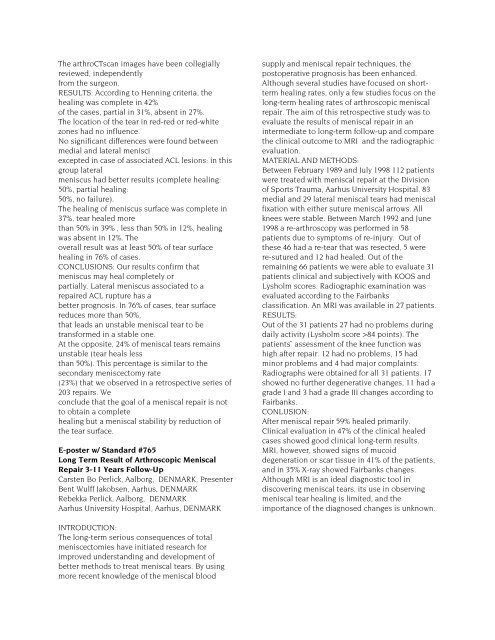POSTER ABSTRACTS - ISAKOS
POSTER ABSTRACTS - ISAKOS
POSTER ABSTRACTS - ISAKOS
You also want an ePaper? Increase the reach of your titles
YUMPU automatically turns print PDFs into web optimized ePapers that Google loves.
The arthroCTscan images have been collegially<br />
reviewed, independently<br />
from the surgeon.<br />
RESULTS: According to Henning criteria, the<br />
healing was complete in 42%<br />
of the cases, partial in 31%, absent in 27%.<br />
The location of the tear in red-red or red-white<br />
zones had no influence.<br />
No significant differences were found between<br />
medial and lateral menisci<br />
excepted in case of associated ACL lesions: in this<br />
group lateral<br />
meniscus had better results (complete healing:<br />
50%, partial healing:<br />
50%, no failure).<br />
The healing of meniscus surface was complete in<br />
37%, tear healed more<br />
than 50% in 39% , less than 50% in 12%, healing<br />
was absent in 12%. The<br />
overall result was at least 50% of tear surface<br />
healing in 76% of cases.<br />
CONCLUSIONS: Our results confirm that<br />
meniscus may heal completely or<br />
partially. Lateral meniscus associated to a<br />
repaired ACL rupture has a<br />
better prognosis. In 76% of cases, tear surface<br />
reduces more than 50%,<br />
that leads an unstable meniscal tear to be<br />
transformed in a stable one.<br />
At the opposite, 24% of meniscal tears remains<br />
unstable (tear heals less<br />
than 50%). This percentage is similar to the<br />
secondary meniscectomy rate<br />
(23%) that we observed in a retrospective series of<br />
203 repairs. We<br />
conclude that the goal of a meniscal repair is not<br />
to obtain a complete<br />
healing but a meniscal stability by reduction of<br />
the tear surface.<br />
E-poster w/ Standard #765<br />
Long Term Result of Arthroscopic Meniscal<br />
Repair 3-11 Years Follow-Up<br />
Carsten Bo Perlick, Aalborg, DENMARK, Presenter<br />
Bent Wulff Jakobsen, Aarhus, DENMARK<br />
Rebekka Perlick, Aalborg, DENMARK<br />
Aarhus University Hospital, Aarhus, DENMARK<br />
supply and meniscal repair techniques, the<br />
postoperative prognosis has been enhanced.<br />
Although several studies have focused on shortterm<br />
healing rates, only a few studies focus on the<br />
long-term healing rates of arthroscopic meniscal<br />
repair. The aim of this retrospective study was to<br />
evaluate the results of meniscal repair in an<br />
intermediate to long-term follow-up and compare<br />
the clinical outcome to MRI and the radiographic<br />
evaluation.<br />
MATERIAL AND METHODS:<br />
Between February 1989 and July 1998 112 patients<br />
were treated with meniscal repair at the Division<br />
of Sports Trauma, Aarhus University Hospital. 83<br />
medial and 29 lateral meniscal tears had meniscal<br />
fixation with either suture meniscal arrows. All<br />
knees were stable. Between March 1992 and June<br />
1998 a re-arthroscopy was performed in 58<br />
patients due to symptoms of re-injury. Out of<br />
these 46 had a re-tear that was resected, 5 were<br />
re-sutured and 12 had healed. Out of the<br />
remaining 66 patients we were able to evaluate 31<br />
patients clinical and subjectively with KOOS and<br />
Lysholm scores. Radiographic examination was<br />
evaluated according to the Fairbanks<br />
classification. An MRI was available in 27 patients.<br />
RESULTS:<br />
Out of the 31 patients 27 had no problems during<br />
daily activity (Lysholm score >84 points). The<br />
patients` assessment of the knee function was<br />
high after repair. 12 had no problems, 15 had<br />
minor problems and 4 had major complaints.<br />
Radiographs were obtained for all 31 patients. 17<br />
showed no further degenerative changes, 11 had a<br />
grade I and 3 had a grade III changes according to<br />
Fairbanks.<br />
CONLUSION:<br />
After meniscal repair 59% healed primarily.<br />
Clinical evaluation in 47% of the clinical healed<br />
cases showed good clinical long-term results.<br />
MRI, however, showed signs of mucoid<br />
degeneration or scar tissue in 41% of the patients,<br />
and in 35% X-ray showed Fairbanks changes.<br />
Although MRI is an ideal diagnostic tool in<br />
discovering meniscal tears, its use in observing<br />
meniscal tear healing is limited, and the<br />
importance of the diagnosed changes is unknown.<br />
INTRODUCTION:<br />
The long-term serious consequences of total<br />
meniscectomies have initiated research for<br />
improved understanding and development of<br />
better methods to treat meniscal tears. By using<br />
more recent knowledge of the meniscal blood
















